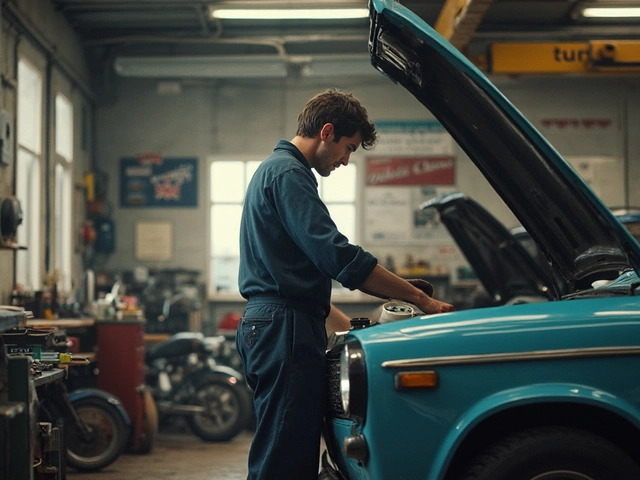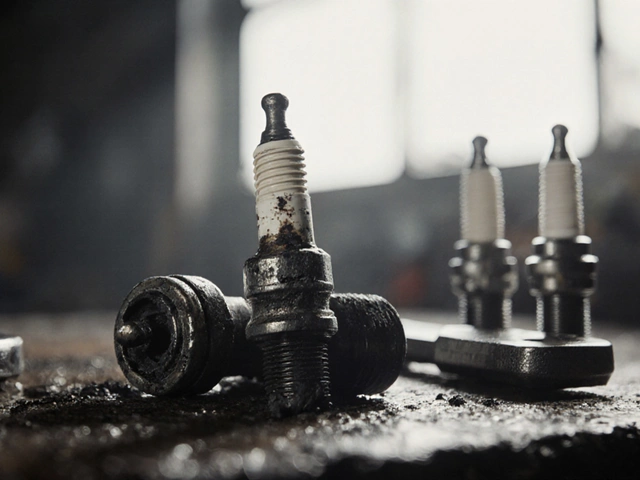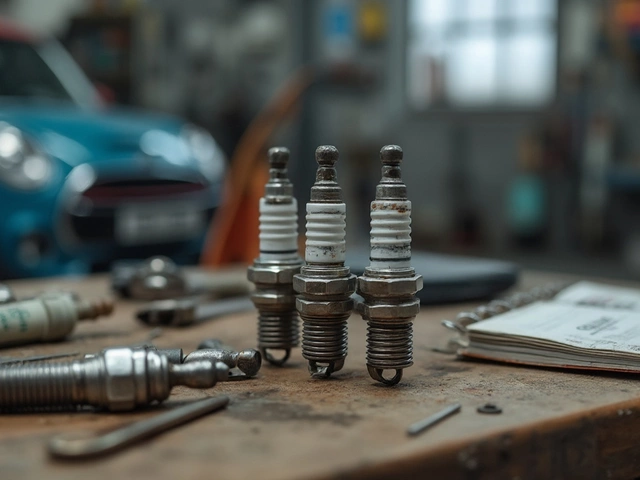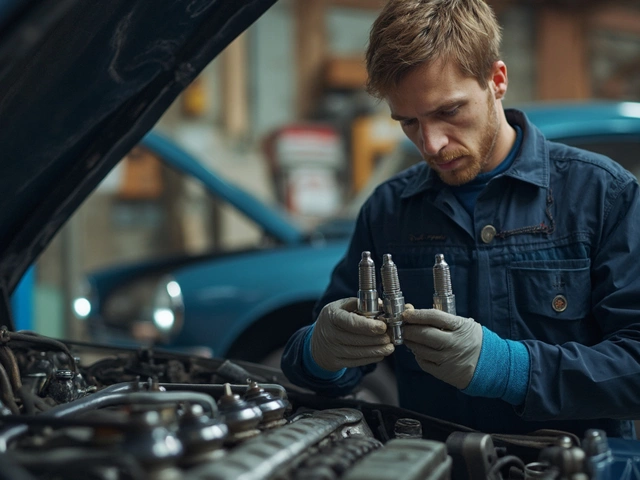Driving along a winding country road can be one of life's great joys, as long as your car's suspension system is in perfect shape. But when bumps become more bone-jarring than delightful, it's time to listen to what your vehicle might be telling you. Recognizing the signs of trouble with your front suspension isn't just a task for the tech-savvy; it's something any car owner can, and should, be adept at.
By understanding the symptoms and consequences of a bad suspension, you not only prolong the life of your car but also ensure your safety and comfort on the road. While cars don't often spell out their problems in big neon letters, knowing where to look and what to listen for can make all the difference. Whether you're hearing a strange clunk or feeling a wobbly wheel, we've got the guidance you need to diagnose, understand, and address suspension issues before they morph into serious problems.
- Introduction to Suspension Issues
- Common Symptoms of Bad Front Suspension
- How to Physically Inspect Your Suspension
- DIY Suspension Testing Tips
- When to Consult a Professional
- Maintaining Your Suspension System
Introduction to Suspension Issues
The suspension in your vehicle is far more than just a collection of springs and shocks; it's the very thing that makes your ride smooth and keeps your car handling like it’s supposed to. At its core, a car's suspension system is designed to maximize the friction between the tires and the road surface, providing steering stability with good handling and ensuring the comfort of passengers. When speaking of suspension, the parts that usually come to mind are shocks, struts, springs, and control arms. Each component plays a crucial role in the symphony of vehicle dynamics, where neglecting one instrument can lead to a discordant and uncomfortable ride.
Imagine you're cruising through a scenic route and suddenly, every small bump is felt directly in your spine. This is often one of the most tangible signs that something is astray with the front suspension. But what causes these issues to arise? Wear and tear is one of the most common culprits. As your vehicle accumulates miles, the suspension system components are subjected to a constant cycle of compression and rebound, which gradually degrade alloyed metals and flexible rubber bushings. Additionally, aggressive driving habits, frequent travel on bumpy roads, and ignoring regular maintenance routines can all accelerate the wear of these components.
Understanding the Importance
Statistics show that most drivers will experience some sort of suspension problem by the time their car hits the 100,000-mile mark, with worn-out components contributing to as much as 12% of vehicular accidents. A well-maintained suspension isn't just about comfort; it's intimately linked to safety. For instance, worn shocks can increase your stopping distance by up to 22%. This is not just about a bumpy ride; it's about having the assurance that your car will behave properly during a sudden evasive maneuver. As Pulitzer Prize-winning journalist Dan Neil once quipped in an automotive review,
"In the grand scheme of vehicular enjoyment, a neglectful suspension is akin to buying a sports car and driving in loafers."Emphasizing this, one can never underestimate the importance of regular checks and swift action when the phone calls for replacements or repairs.
Common Symptoms of Bad Front Suspension
When it comes to the health of your vehicle, your front suspension plays a crucial role in ensuring a smooth and balanced ride. Recognizing the red flags of a failing suspension early can save you from bigger headaches down the line. One of the most telling symptoms is unusual noises like clunking or knocking sounds when driving over bumps. These sounds might indicate worn-out suspension components like bushings or ball joints. Just imagine driving along your neighborhood street, and every small bump sounds like a disaster unfolding beneath you.
Another significant sign to pay attention to is uneven tire wear. If you notice that the tread on your tires is wearing more on one side, it often signals a misalignment caused by a suspension problem. This can also lead to uneven and unstable handling, making your vehicle drift or pull to one side. This symptom isn't just a nuisance; it can be dangerous, especially if you're caught reacting too slowly during emergency maneuvers. According to a survey by the National Highway Traffic Safety Administration, approximately 8% of car accidents are directly linked to defective suspensions.
Then there's the matter of longer stopping distances. If your car's nose dives drastically every time you brake, your front suspension might not be distributing weight as efficiently as it should. A well-working suspension helps distribute braking force and manage the weight of your vehicle. Failing suspension can cause a dip that might not just cost you performance but could be life-threatening. Additionally, this problem could increase the risk of skidding or losing control when stopping abruptly.
Experiencing a bumpy and uncomfortable ride is, surprisingly, a late sign of worn suspension. If passengers complain or you find yourself constantly jostling inside the cabin, it might not only be a maintenance issue but also a sign of severe suspension wear. “A properly functioning suspension keeps the vehicle under control and comfortable for the driver and passengers,” says Tom Magliozzi, co-host of the popular radio show Car Talk. How a car absorbs impacts is often underestimated until it's too late, leaving you with not just repair bills but potential medical ones too.
Finally, don’t overlook the steering. If turning the wheel becomes a wrestling match, or if your car doesn't seem to be responding precisely to your steering inputs, it's a call for attention. Sloppy handling or steering that feels loose might indicate issues with the suspension geometry or worn linkages that need immediate addressing. Ignoring this can result in less control and potentially hazardous situations, especially under adverse driving conditions.
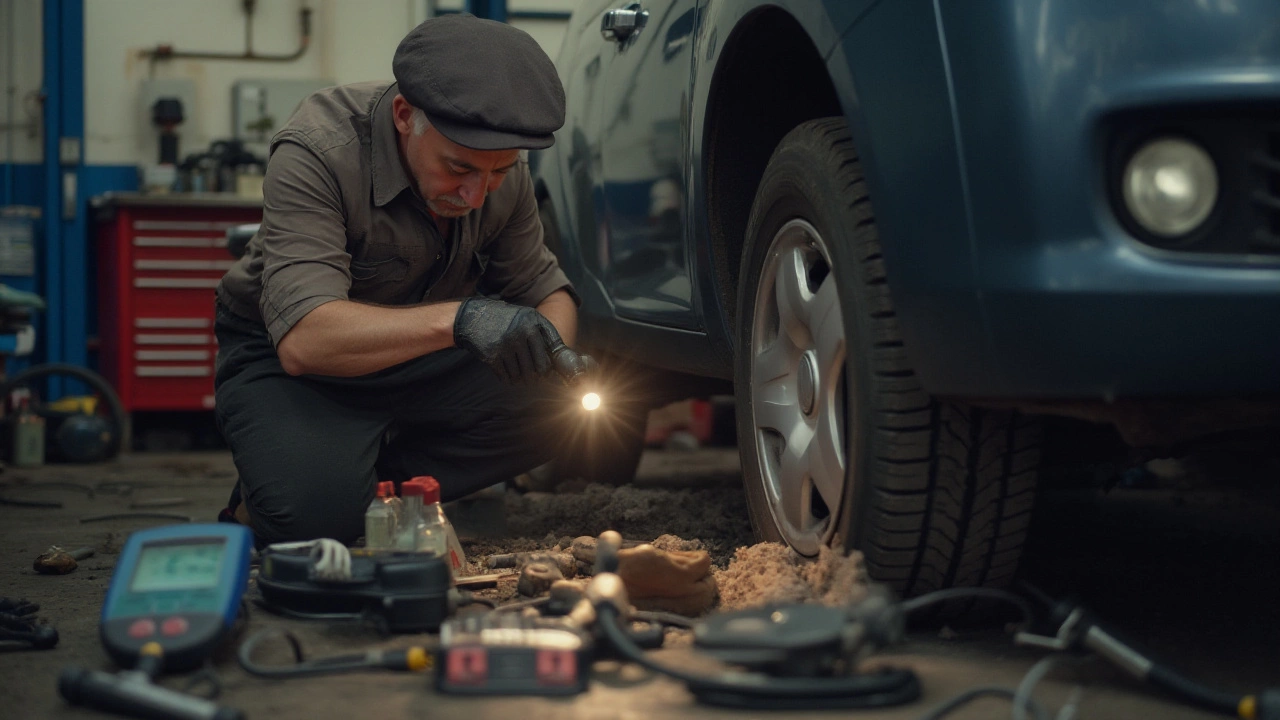
How to Physically Inspect Your Suspension
Getting hands-on with your vehicle isn't just for mechanics. Performing a physical inspection of your car’s front suspension system can be enlightening and very satisfying. It’s like a maintenance treasure hunt where you seek out creaks, leaks, or other little clues that might point to worn or damaged parts. Begin by parking your car on a level surface and ensuring it’s stable. Grab a flashlight and let’s dive in.
First, visually examine the tires. Uneven wear can often be the first sign of a suspension problem. If you notice that the tread has worn more on one side than the other, it could indicate an alignment issue or a faulty suspension component. Next, check for leaks near any of the suspension parts. Look under your vehicle for signs of oil or hydraulic fluid on the shock absorbers. Such leaks may suggest these components need replacing or repairing.
Once you’ve done a visual check, it’s time to get tactile. Bounce each corner of your car up and down and let go. The vehicle should rebound smoothly without excessive bounce. More than two bounces might point to worn shock absorbers.
“A well-maintained suspension doesn't suffer fools gladly,” says Jake Nilsson, an automotive engineer with over 20 years of expertise.Also, listen carefully. Clicking or creaking noises while performing these checks can hint at worn ball joints or a failing control arm, both critical parts of your front end.
Now, get a little help and test the steering components. With a friend turning the steering wheel side to side, watch the tie rods, ball joints, and bushings. They should move smoothly without any erratic jerkiness or loose play. If things appear shaky or unreliable, these parts might require attention. One pro tip is to use a floor jack to slightly lift the vehicle so you can easily jiggle the wheels and feel for any signs of looseness.
Finally, check your coil springs. These robust metal spirals absorb a lot of stress and can snap or sag with time. They should be intact with no cracks, and they should sit evenly. If one corner of your vehicle sags lower than the rest, it could be a spring issue. Don't forget, though, that these tasks, while simple, can sometimes require specific tools or expertise that might be challenging for some. If doubts linger, consulting with a professional mechanic is always a wise choice.
Regular checks and maintenance of your vehicle's suspension system ensure long-term reliability. Remember, identifying small problems early can prevent larger ones from developing, saving you from potentially expensive repairs down the line. Here’s a quick checklist for all the components we've explored:
- Uneven tire wear
- Leaks from shocks
- Excessive bouncing
- Noisy steering components
- Condition of coil springs
DIY Suspension Testing Tips
If you're determined to take matters into your own hands and check out potential suspension problems without an immediate trip to the mechanic, there are a few straightforward tests that can signal whether it's time to schedule that appointment. Testing your car's suspension at home doesn't require a full garage setup, just some attention and a dash of curiosity. The first thing to do is consider the bounce test, a classic for good reason. By pushing down heavily on the hood of your car and releasing, you should count how many times it bounces before coming to a rest. Ideally, it should settle within one or two movements; more than that could indicate weakened shocks or struts.
Tire inspection is another DIY strategy, providing more clues than most people realize. Uneven tire wear is a glaring red flag when it comes to suspension issues. If you notice that the outer edges of your tires are more worn down than the centers, this could mean your suspension isn't holding the wheels evenly on the road. Another sign to look out for is cupping, which can almost feel like scooped patches in the tread, often linked to a malfunctioning suspension system.
Don't underestimate the power of your senses, particularly your ears. Strange noises like clunks, bangs, or squeaks heard during your usual drives should not be ignored. These sounds often hint at issues within the front suspension, such as worn bushings or failing ball joints. Listen carefully, try to pinpoint when these sounds occur, and jot down the details. This information can greatly aid a professional later, should a more thorough inspection become necessary.
Feeling bold? Try the alignment checks. If you're car-savvy and have access to a flat and safe area, observe your car's natural alignment. Simply release the wheel while moving slowly in a straight line. If your car pulls significantly to one side without steering input, it could imply that your suspension alignment is off. Be mindful that this could also relate to under-inflated tires or alignment issues not strictly related to the suspension.
If readings and measurements are your thing, a more quantitative examination of your car's suspension can involve the use of a jack and tools to precisely measure suspension parts for wear and tear. This might be the most technical test for a home enthusiast but provides valuable information. Checking for play in the steering and suspension components by assessing the rigidity of control arms and the steering linkage can indicate significant wear.
According to an industry veteran whom I once interviewed, "Keeping an eye on even the smallest of changes in your vehicle's behavior keeps you ahead of costly repairs and ensures peace of mind on every journey." This advice resonates because quite often, being proactive with small checks prevents future breakdowns.
Each of these tests offers insight into what might be happening with your vehicle’s suspension system – which, while often subtle, can greatly influence driving comfort and safety. Doing these checks routinely can keep your vehicle in top shape and save considerable money by catching problems before they spiral. Remember, while you can gain a lot of useful information from these DIY tests, seeking professional help at the first sign of a serious problem is always recommended.

When to Consult a Professional
Understanding when to seek the expertise of a professional mechanic can make a crucial difference in maintaining your vehicle's health and your safety on the road. While many symptoms of bad suspension problems can potentially be diagnosed and even fixed by a seasoned DIY enthusiast, there are critical points at which professional intervention becomes necessary. This is especially true if you're facing issues beyond your comfort level or when the symptoms point to more severe problems. One of the definitive signs to look for is the persistent clunking noise emanating from your vehicle, especially when driving over bumps or making sharp turns. Such sounds might hint at more than just worn-out parts but potentially serious structural concerns.
If you find that your car begins to sway or lean heavily to one side during driving, it's a clear indication you should not delay in consulting a pro. These symptoms often suggest issues in the suspension alignment or sagging springs that require expert tools and knowledge to diagnose correctly. Moreover, uneven or rapid tire wear often goes unnoticed until it's well advanced; however, if you observe a strange wearing pattern that can't be explained by simple tire over-inflation or under-inflation, it's time to visit a repair shop. Professionals can use their experience and specialized equipment to assess the width, camber, and toe alignment to restore safety and performance.
"Leaving a nagging suspension issue unattended can lead to more dangerous mechanical failures down the line," cautions expert mechanic and auto safey advocate, Mike Zimmerman. "There are times when only a trained eye can catch the nuances of a complex suspension system."
In addition to sound and balance issues, leaks can signify major suspension troubles. If you spot any visible fluid leaks under your car, a professional assessment is mandatory because these might indicate a failing hydraulic system or deteriorating seals in shock absorbers. Specialists have the right diagnostic tools that can efficiently find tiny fissures and leaks that are invisible to the untrained eye. If you feel excessive bouncing when testing your shocks, known as the 'bounce test', it may be a sign that springs or shock absorbers are failing beyond repair. With tools that measure the efficiency of dampening over varied speeds and terrains, professionals ensure the system operates reliably.
Lastly, while online resources and forums provide ample information, there is no substitute for the expert handling and advice a seasoned mechanic can offer. Recognizing when to tap this resource is key. The investment might save money in the longer term by preventing catastrophic failures and expensive repairs. Remember, a fully functional front suspension does not only ensure a smooth ride, it ensures a safe one. Keeping communication with a trusted mechanic and regular check-ups should be a part of your vehicle maintenance regimen.
Maintaining Your Suspension System
Keeping your suspension system in tip-top shape is crucial for ensuring your vehicle performs well and provides you with a comfortable ride. The suspension is responsible for maintaining friction between the tires and the road, giving you control over the vehicle. Regular checks and maintenance can save you from the surprise of unexpected shocks. Start by keeping an eye on your tire pressure. Properly inflated tires can have a significant impact not just on your suspension, but on your gas mileage and safety too. Make it a point to check your tire pressure at least once a month, and especially before long trips.
Next, focus on the suspension parts themselves. Inspect the shocks and struts for any signs of leakage or wear. Notice if your vehicle has started leaning to one side? A sagging corner could suggest that one of your springs is wearing out. Regular wheel alignment and balanced tires can prevent many common suspension problems, such as uneven tire wear. It's also a good practice to have your suspension parts professionally checked at least once a year, depending on your driving conditions and habits.
Lubrication is another key aspect of suspension maintenance. Keeping components like ball joints and rubber bushings appropriately lubricated prevents rust and reduces the wear and tear caused by friction. During maintenance, look for any cracks or damage in these areas. When washing your car, ensure to spray under the car to get rid of mud and grime that could affect the performance of the suspension. "Your car’s suspension is like its skeleton, and the parts work together to keep you safe," notes a driving expert at Auto Mechanics Quarterly. "Ignoring it is like ignoring a bone ache until it becomes a fracture."
Some statistics underscore the value of suspension care: according to a study by the Auto Care Association, nearly 75% of vehicles on the road today need new shocks or struts. Proactive care not only saves money on major repairs but can also extend the longevity of your vehicle considerably. Create a regular maintenance schedule for your vehicle repair needs. If you're doing a lot of driving on rough roads, consider getting your suspension checked more frequently, as these conditions can accelerate wear and tear.
| Suspension Part | Estimated Lifespan |
|---|---|
| Shocks and Struts | 50,000 to 100,000 miles |
| Ball Joints | 70,000 to 150,000 miles |
| Springs | 100,000 to 150,000 miles |
Finally, be attentive to unusual sounds while driving. Creaks, groans, or clunking noises can be the first signs that your suspension needs attention. So, next time you hit the road, listen closely. Maintaining your suspension system isn’t just a task for the mechanically inclined; it’s a fundamental part of responsible car maintenance. By being proactive, you not only enhance your car’s performance but also your peace of mind when you buckle up for a drive.


